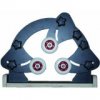Mark Hepburn
Artist & Chef
Sorry if this is an old, worn out question but I'm not seeing many answers in the old threads:
Can anyone recommend a good method to steady a hollow form for my Jet 1642? I'm turning an item (and plan to turn more) about 16" long or deep, with diameters ranging from 6 to 9 inches.
I looked at the Oneway, which is the two-wheel setup and while they're listed on Amazon and elsewhere for a number of lathes, I don't see the Jet. And I wonder how well it works as it only hugs one side (on the other hand it is a Oneway product).
There is also the Carter multi rest but it's nearly $400!
Amazon also lists a product called the RMWoodco rest. Here's a photo:

I'm sure I can make one and have looked around at lots of plans, but in truth I'd rather be turning than making jigs.
Can anyone recommend something? I expect to do quite a few projects over time so your comments would be a great help.
Thanks,
Mark
Can anyone recommend a good method to steady a hollow form for my Jet 1642? I'm turning an item (and plan to turn more) about 16" long or deep, with diameters ranging from 6 to 9 inches.
I looked at the Oneway, which is the two-wheel setup and while they're listed on Amazon and elsewhere for a number of lathes, I don't see the Jet. And I wonder how well it works as it only hugs one side (on the other hand it is a Oneway product).
There is also the Carter multi rest but it's nearly $400!
Amazon also lists a product called the RMWoodco rest. Here's a photo:

I'm sure I can make one and have looked around at lots of plans, but in truth I'd rather be turning than making jigs.
Can anyone recommend something? I expect to do quite a few projects over time so your comments would be a great help.
Thanks,
Mark


